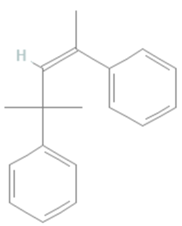GC-MS profiling of Volatile Metabolites produced by Enterococcus faecalis and Evaluation of Its Antibacterial and Antifungal Activity
Abstract
Aims and Objectives:
The purpose of this laboratory study was to study the truly biologically active chemical compounds produced by Enterococcus faecalis and to evaluate the antibacterial and antifungal bioactivity of these products.
Method:
In this research, (GC-MS) techniques were used to investigate the biochemical components that are commonly referred to as bioactive substances. At the same time, these bioactive substances are referred to as bioactive secondary metabolites. Furthermore, the ethanolic extract of Enterococcus faecalis was tested in an experimental laboratory to determine whether it actually has effective antibacterial and antifungal properties.
Results:
Using GC-MS analysis on Enterococcus faecalis, the presence of the following bioactive components was experimentaly identified: 2-methyl-1-propenol, 2-pentene, 4-methyl-2,4-diphenyl, 2,4-methyl Dioxo-4-phenylbutanoate, 2 -pentnone, -phenylbutan-2-yl acetate, methyl 2-(butn-2-ylsulfanyl)acetate, trithylene glycol bis(2-ethyl butyrate), methyl 2-(butan-2-ylsulfanyl)) Acetate, triethylene glycol PS (2-ethyl butyrate), 3-mercapto-2-pentenone, ethyl 2-ethylhexanoate, 3-methylbutyl acetate. Metabolites of Enterococcus faecalis showed significant activity against Proteus mirabilis (20.18 ± 0.04). Metabolites of Enterococcus faecalis were highly active against Fusarium oxyporum (13.76 ± 0.17).
Full text article
References
REFERENCES
Poh CH, Oh HML, Tan AL. Epidemiology and clinical outcome of enterococcal bacteraemia in an acute care hospital. J Infect. 2006;52 (5):383–386.
Jett BD, Huycke MM, Gilmore MS. Virulence of enterococci. Clin Microbiol Rev. 1994;7(4):462–478.
Ruoff KL, De La Maza L, Murtagh MJ, Spargo JD, Ferraro MJ. Species identities of enterococci isolated from clinical specimens. J Clin Microbiol. 1990;28(3):435–437.
Kreft B, Marre R, Schramm U, Wirth R. Aggregation substance of Enterococcus faecalis mediates adhesion to cultured renal tubular cells. Infect Immun. 1992;60(1):25–30.
Budavari S M, Saunders G L, Liebowitz L D, Khoosal M, Crewe-Brown H. Emergence of vancomycin-resistant enterococci in South Africa. S Afr Med J. 1997; 87(11): 1557
Cetinkaya Y, Falk P, Mayhall C. Vancomycin-resistant enterococci. Clin Microbiol Rev. 2000; 13(4): 686–707
Chan E D, Iseman M. Multidrug-resistant and extensively drug-resistant tuberculosis: a review. Curr Opin Infect Dis. 2008; 21(6): 587–595
Manson JM, Keis S, Smith JMB, Cook GM. 2003. Characterization of a vancomycin-resistant Enterococcus faecalis (VREF) isolate from a dog with mastitis: further evidence of a clonal lineage of VREF in New Zealand. J. Clin. Microbiol. 41:3331–3333. 10.1128/JCM.41.7.3331-3333.2003
Smart KF, Aggio RBM, Van Houtte JR, Villas-Bôas SG. 2010. Analytical platform for metabolome analysis of microbial cells using methyl chloroformate derivatization followed by gas chromatography-mass spectrometry. Nat. Protoc. 5:1709–1729. 10.1038/nprot.2010.108
Aggio R, Villas-Bôas SG, Ruggiero K. Metab: an R package for high-throughput analysis of metabolomics data generated by GC-MS. Bioinformatics. 2011; 27:2316–2318.
Otto M. Targeted immunotherapy for staphylococcal infections. BioDrugs. 2008;22(1):27–36.
Patti JM, Allen,BL, McGavin MJ, Hook M. MSCRAMM-mediated adherence of microorganisms to host tissues. Annu Rev Microbiol. 1994;48(1):585–617.
Donlan RM. Biofilms: microbial life on surfaces. Emerg Infect Dis. 2002;8(9):881–890.
Mohamed JA, Huang DB. Biofilm formation by enterococci. J Med Microbiol. 2007;56:1581–1588.
Ike Y, Hashimoto H, Clewell DB. Hemolysin of Streptococcus faecalis subspecies zymogenes contributes to virulence in mice. Infect Immun. 1984;45(2):528–530.
Poh CH, Oh HML, Tan AL. 2006. Epidemiology and clinical outcome of enterococcal bacteraemia in an acute care hospital. J. Infect. 2005; 52:383–386.
Livermore DM. Has the era of untreatable infections arrived? J. Antimicrob. Chemother. 2009; 64(Suppl 1):i29–i36.
Neely AN, Maley MP. Survival of enterococci and staphylococci on hospital fabrics and plastic. J. Clin. Microbiol. 2000; 38:724–726.
Weigel LM, Clewell DB, Gill SR, Clark NC, McDougal LK, Flannagan SE, Kolonay JF, Shetty J, Killgore GE, Tenover FC. Genetic analysis of a high-level vancomycin-resistant isolate of Staphylococcus aureus. Science. 2003; 302:1569–1571.
Authors
Copyright (c) 2024 https://creativecommons.org/licenses/by/4.0/

This work is licensed under a Creative Commons Attribution 4.0 International License.
